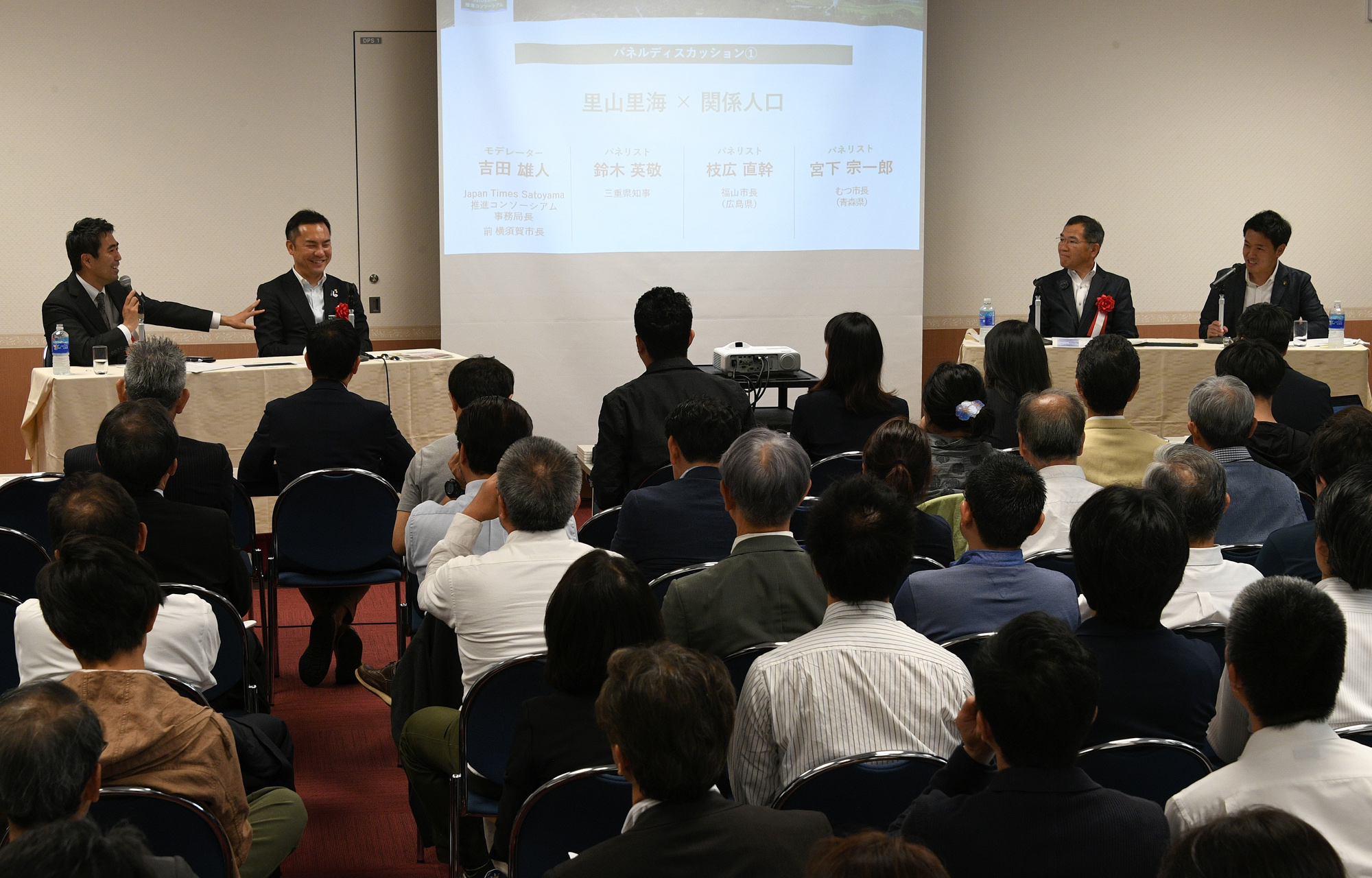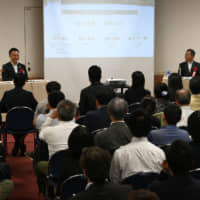At a recent forum in Tokyo, several municipal leaders stressed the importance of nurturing a pool of nonresident supporters who have a certain level of interaction with a municipality to rejuvenate regions, rather than just sticking to trying to increase the number of residents to stem depopulation.
Mie Prefecture Gov. Eikei Suzuki; Mayor of Fukuyama, Hiroshima Prefecture, Naoki Edahiro; and Mayor of Mutsu, Aomori Prefecture, Soichiro Miyashita took part in a panel discussion on how to promote kankei jinkō (people who are committed to a particular area) at the Japan Times Satoyama Consortium symposium on June 4.
The panel, part of the symposium to introduce relevant efforts surrounding satoyama (mountains and woods maintained by residents of the adjacent communities) in rural areas, was moderated by Yuto Yoshida, the secretariat chief of the satoyama consortium and former mayor of Yokosuka, Kanagawa Prefecture.
Introducing positive economic and demographic trends seen in Mie, which has a population of around 1.8 million, Suzuki talked about the prefecture's initiative to increase kankei jinkō.
"Mie is doing well from a macroeconomic viewpoint as the gross domestic product of the prefecture, economic growth rate and tax revenue growth rate are all on an upward trend," Suzuki said. About 1,000 people have moved to Mie from other prefectures over the four years from 2015, according to the figures in Suzuki's presentation.
However, he stressed that clinging to the idea that resident numbers should be increased to stop depopulation would not solve the problem on a national scale.
"That is merely a transfer of people from one place to another," Suzuki said. Miyashita and Edahiro nodded in agreement with the governor's remark.
Suzuki went on to explain the prefecture's engagement in increasing kankei jinkō numbers as a way to preserve what is important in the community, while also maintaining the diversity of people and their lives.
The prefecture launched a project called Wataraiken (Watarai Prefecture) as part of Mie's efforts to increase kankei jinkō and revitalize areas in the prefecture suffering from serious depopulation. The name was used by a former prefecture that once made up the southern half of current day Mie, located in central Japan.
"It is based on the collaboration of multiple municipalities. Competition among municipalities does stimulate growth, but some goals are more attainable when people and communities are connected," Suzuki said.
Anyone, regardless of their place of residence, can apply for citizenship of Wataraiken and participate in projects such as cleaning activities, preserving a local festival, and fishing and farming experiences that take place in various areas of Wataraiken.
"We have about 1,000 citizens now, half of whom are from outside the prefecture," the governor explained.
He noted that the essence of increasing the number of kankei jinkō within a region is to offer diverse ways to relate to the place.
The city of Fukuyama has a population of about 470,000 and is situated at the eastern end of Hiroshima Prefecture facing the Seto Inland Sea. It is known as the city of roses, the symbol of the city's recovery from an extensive air raid that destroyed about 80 percent of the city's center in 1945.
Edahiro said that what's important is to incorporate outside stimulus — kankei jinkō — to inspire new ideas to revitalize the region facing depopulation.
"Since last year, five business people who work at companies in other parts of Japan but are allowed to have second or side jobs have been participating as strategy promotion managers on Fukuyama regional projects," Edahiro said. "They are not originally from Fukuyama, but there was a match between their need for self-realization using their skills and resources and our need for new stimulus."
Meanwhile, Mutsu's Miyashita, who heads the city of about 57,000 located in the northernmost part of Honshu, noted there is no stopping the depopulation trend. "What's important is that each municipality can design its own future," he said.
Miyashita noted that local governments do not have to rely on only the residents as being part of this process. The city now has 150 "Ouen (cheering) Producers," consisting of both residents and nonresidents, who make voluntary policy recommendations.
"They have different backgrounds and occupations. They do not have any stereotypical ideas of what a municipality can or cannot do, which has proven to be the key to design various future scenarios for our city," he said.
The mayor concluded the session by saying that there are people who continue to live in their hometowns, however inconvenient it may be. They feel responsible for the land and the community in which they were born and raised. He then encouraged the audience to be part of the efforts to revitalize such communities across the nation in their own way.
This series introduces municipalities and local companies promoting the beauty and excellence of deep Japan.



















With your current subscription plan you can comment on stories. However, before writing your first comment, please create a display name in the Profile section of your subscriber account page.